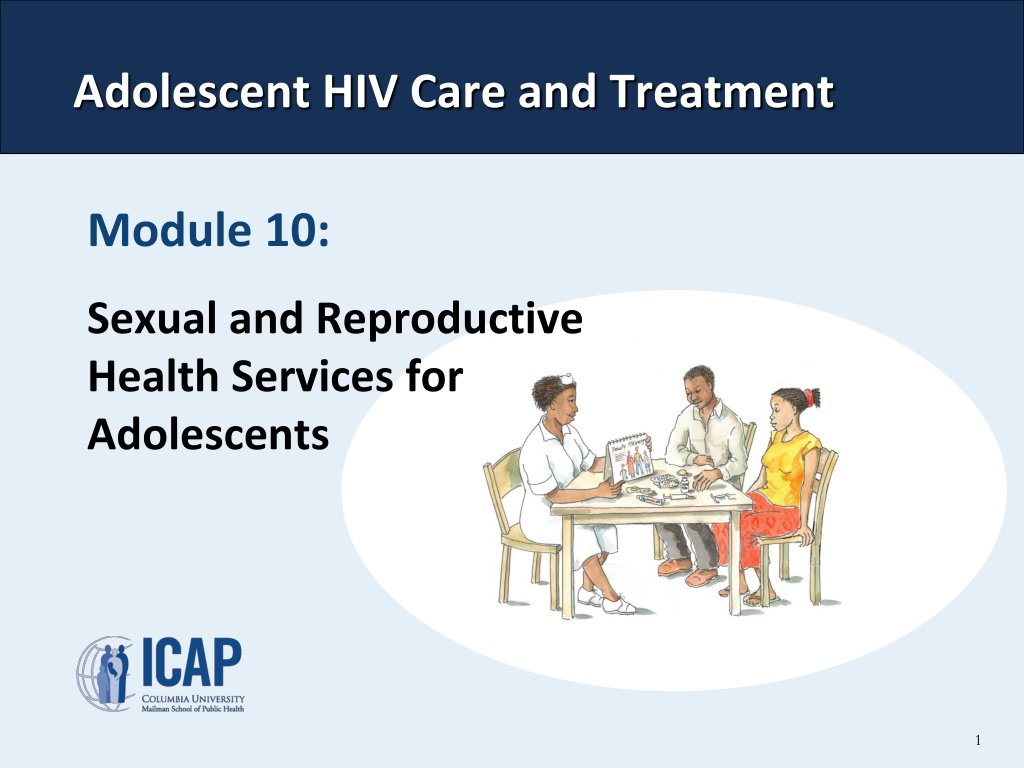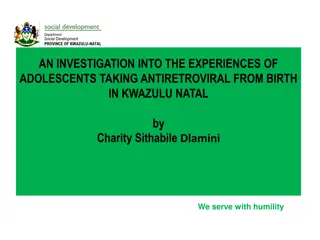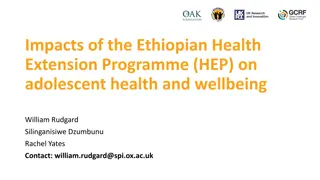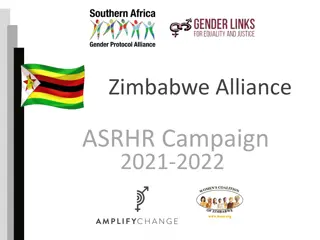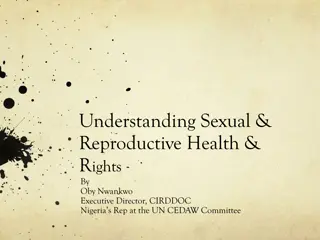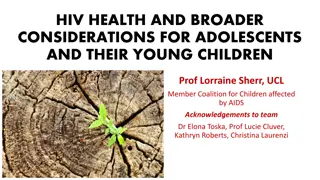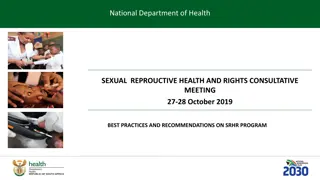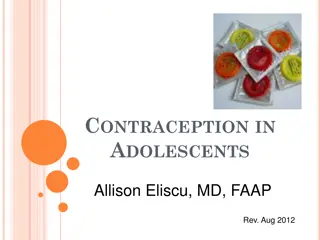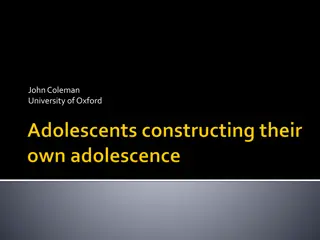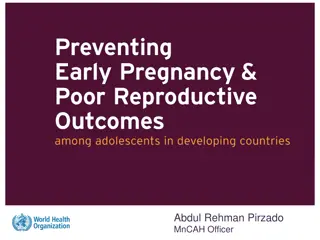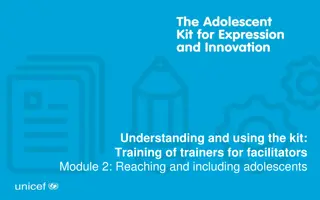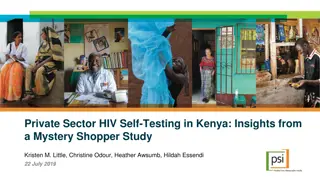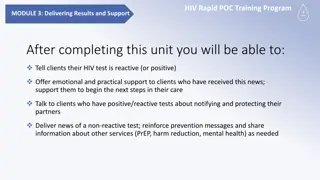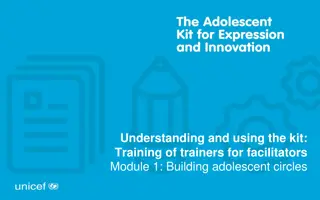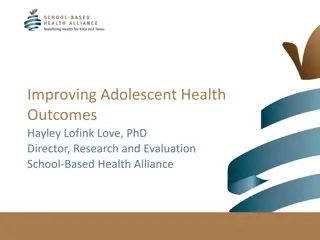Adolescent HIV Care and Treatment: Module 10 - Sexual and Reproductive Health for Adolescents
This module focuses on addressing adolescent sexuality, sexual orientation, and the impact of HIV on adolescents' sexual health. It covers key terms, safer sex practices, sexual risk screening, STI screening, and strategies to make sexual and reproductive health services more adolescent-friendly.
Download Presentation

Please find below an Image/Link to download the presentation.
The content on the website is provided AS IS for your information and personal use only. It may not be sold, licensed, or shared on other websites without obtaining consent from the author. Download presentation by click this link. If you encounter any issues during the download, it is possible that the publisher has removed the file from their server.
E N D
Presentation Transcript
Adolescent HIV Care and Treatment Module 10: Sexual and Reproductive Health Services for Adolescents 1
Module 10 Learning Objectives After completing this module, participants will be able to: Reflect on their own attitudes, values, and beliefs about adolescent sexuality, and discuss how these may affect their work with adolescents Define key terms related to sex, sexuality, sexual orientation, and sexual identity Identify potential effects of HIV on adolescents sexuality Define safer sex and discuss how to empower adolescent clients to practice safer sex 2
Module 10 Learning Objectives (Continued) Conduct sexual risk screening and reduction counseling with adolescent clients Explain the importance of and provide STI screening and treatment to adolescent clients List ways to make sexual and reproductive health (SRH) and other clinical examinations more adolescent-friendly 3
Session 10.1 Values Clarification and Introduction 4
Session 10.1 Objectives After completing this session, participants will be able to: Reflect on their own attitudes, values, and beliefs about adolescent sexuality, and discuss how these may affect their work with adolescents 5
Discussion Questions Do you discuss sexual and reproductive health (safer sex, contraception, etc.) with your clients? If so, what topics do you discuss? If you don t discuss SRH issues, why not? 6
Adolescent Sexuality Introduction Sexuality emerges during adolescence and, for many people, mid-late adolescence is also a time when sexual activity begins. Health workers should assume that adolescent clients are already sexually active (or will become sexually active at some point in the future). All members of the multidisciplinary team should: Feel comfortable talking about sexuality and sexual and reproductive health (SRH) with adolescents Be able to offer adolescents non-judgmental sexual education and SRH counseling and services 7
Exercise 1 SRH Values Clarification: Large group exercise 8
Exercise 1: Debriefing What did we learn? Key points: It is important that all health workers caring for ALHIV explore their own attitudes, values, and prejudices related to adolescent sexuality, as well as how these could affect their ability to provide effective care. It is important that health workers be sensitive to the emerging feelings of their adolescent clients, that they make them feel comfortable, and that they make them feel it is safe to talk openly and honestly in the clinic setting. 9
Questions or comments on this session? 10
Session 10.2 Adolescent Sexuality and HIV 11
Session 10.2 Objectives After completing this session, participants will be able to: Define key terms related to sex, sexuality, sexual orientation, and sexual identity Identify potential effects of HIV on sexuality among adolescents 12
Exercise 2 Key Terms about Sex, Sexuality, and Sexual Orientation: Small group work and large group discussion 13
Exercise 2: Key Terms Sex (verb) Intimacy Heterosexuality Sex (noun) Love Homosexuality Vaginal sex Sexual arousal Bisexuality Anal sex Social roles Transvestism Oral sex Body image Transsexual Sexuality Genitals Transgendered Gender roles Gender Relationship Sexual abuse 14
Exercise 2: Debriefing What did we learn? Key points: Even we, as health workers, sometimes find it difficult to talk about sex and sexuality. Being able to comfortably talk about sex and sexuality within a professional context is the first step toward being able to initiate SRH discussions with clients. Our first priority as health workers is to provide care and support to our clients. This means never judging them or making them feel abnormal. 15
Sex (as in Sexual Activity) Also referred to as intercourse or sexual intercourse, and includes: Inserting fingers or objects into the vagina or anus Masturbating (alone or with a partner) Having sex with men, women, or both men and women Vaginal sex: when the penis or fingers go into the vagina Anal sex: when the penis or fingers go into the anus Oral sex: when a person kisses or licks his or her partner s penis, vagina, or anus 16
Unsafe Sex Unsafesex is any kind of sex that puts a person or a person s sexual partners at risk of getting an STI (including HIV) or unwanted pregnancy. HIV is mainly spread to adolescents and adults through unsafe sex. Honest, factual discussions about sex and sexuality can provide adolescents with the information they need to protect themselves and their partners from STIs and unplanned pregnancy. 17
Sexuality Is more than sex and sexual feelings Includes all the feelings, thoughts, and behaviors of being a girl, boy, man, or woman, including feeling attractive, being in love, and being in relationships that include sexual intimacy and physical sexual activity Exists throughout life and is a component of the total expression of who we are as human beings Is a part of us from birth until death Is constantly evolving as we grow and develop For more information on key terms related to sexuality, see your Participant Manual. 18
Discussion Questions What are some of the ways adolescents may express their sexuality? What challenges do you think adolescents may face in expressing their sexuality? See Appendix 10A: Journal Article, which presents data on sexual behaviors and desires among ALHIV in Uganda. 19
Remember: Sexual behaviors include much more than just penis- vagina sex. If you do not talk about sex and sexual behaviors with clients, they may not get the information, skills, and supplies they need to protect themselves and their partners. We should not project our own values onto clients. ALHIV should always be made to feel comfortable talking about their sexual concerns, questions, and behaviors and that there is no risk of judgment. 20
Discussion Questions How many of your clients are homosexual or bisexual? As a health worker, do you feel you provide these clients with the support they need? Why or why not? 21
Sexual Orientation and Identity Adolescence is a time of sexual experimentation and defining one s sexual identity. An adolescent who realizes that he or she may be gay, bisexual, or transgendered may feel isolated and depressed. It is the health worker s responsibility to: Stress that homosexual, bisexual, and transsexual/ transgendered behaviour is NORMAL. Help the adolescent cope with his or her sexual orientation and accept his or her feelings. You do not have to be an expert to help. Be willing to listen in a non-judgmental way and to provide any necessary referrals. For more information on key terms related to sexual orientation and identity, see your Participant Manual. 22
Creating a Gay-Friendly Atmosphere Homosexual and bisexual ALHIV are particularly vulnerable: They may experience profound isolation and fear of discovery They are more likely to experience harassment and violence and are at higher risk of dropping out of school, being kicked out of their homes, and experimenting with substances at an early age Reassure youth that they will not be judged and that they are welcome in the clinic Ensure that all youth feel comfortable and are provided with the care, treatment, and support that they need Know where to refer youth for peer and other forms of support 23
Discussion Questions In what way do you think HIV might affect the sexuality of adolescent clients? 24
Effects of HIV on Sexuality Among ALHIV HIV affects everyone differently. Some ALHIV may experience 1 or more of these effects, and others may not experience any: Adolescents may be preoccupied with their developing bodies and body image; may compare themselves to their peers Adolescents wonder and worry about their level of sexual attractiveness ALHIV may have lower self-esteem than their peers; may have increased anxiety about sexuality, sexual relationships, and sexual and reproductive health ALHIV may have concerns about if/how they can have safe sexual relationships; often have fears related to disclosure 25
Effects of HIV on Sexuality Among ALHIV (Continued) ALHIV may have concerns and questions about being able to have children Looking different can be very traumatic for adolescents: ALHIV may begin puberty later and grow and develop more slowly ALHIV are subject to many illnesses, conditions, and drug side effects that may affect the way they look Adolescents who acquired HIV through sexual abuse may have unresolved issues from the trauma related to the abuse 26
Sexual Abuse Has anyone worked with an adolescent client who had experienced sexual abuse? If so, how did you handle it? 27
Sexual Abuse (Continued) Definition: Forced, unwanted, improper, or harmful sexual activity that is inflicted on another person Many victims of sexual abuse are adolescents. Research has documented that 7 34% of girls and 3 29% of boys experience sexual abuse. The most frequent victims of coerced sex are adolescent girls. Sexual abuse can happen inside or outside the home; it can be perpetrated by a partner, family member or friend, or stranger. 28
Sexual Abuse (Continued) Teach young people that they have a right to grow up and live in an environment that is free of physical and sexual violence. Violence should never be considered a normal part of everyday life. Recognizing sexual abuse can be difficult and is rarely a straightforward task. 29
Sexual Abuse (Continued) Identifying sexual abuse: Often, there is no physical evidence that an adolescent has been sexually abused. Changes in the adolescent s behavior are a far more common result. The most reliable and common indicator of sexual abuse is an adolescent s disclosure of the abuse. See Appendix 10B: Adolescent Sexual Abuse. 30
Sexual Abuse (Continued) Sexual abuse should be investigated using a multidisciplinary team approach. Provide package of sexual and gender-based violence (SGBV) services: HIV testing and PEP, following national guidelines A medical exam, including the collection of forensic evidence and an STI assessment The provision of needed medical treatment Pregnancy testing and emergency contraception (for females) Counseling and support A temporary place to stay, if needed for safety A link to the police for an investigation of the assault 31
Exercise 3 OK for Me?: Large group exercise and discussion 32
Exercise 3: Group Discussion Questions Are you surprised by the placement of some of the cards? Which ones surprise you? Does the placement of the cards suggest that some sexual behaviors are right while others are wrong? How do you feel about that? Are there behaviors that are not OK under any circumstances? What does this activity tell us about how adolescent clients might feel when we ask them about their sexual behaviors? How can we make our adolescent clients feel more comfortable talking about their sexual preferences and behaviors at the clinic? 33
Exercise 3: Debriefing What did we learn? Key points: We all have our own values and attitudes about sexual behaviors. However, we must be able to talk openly and comfortably about sex and sexuality with out adolescent clients. Being open, non-judgmental, and truthful about sexuality makes it easier for adolescent clients to accept themselves and to reduce their risk. 34
Questions or comments on this session? 35
Session 10.3 Supporting Adolescent Clients to Practice Safe Sex 36
Session 10.3 Objectives After completing this session, participants will be able to: Define safer sex and discuss how to empower adolescent clients to practice safer sex 37
Discussion Question How is HIV transmitted from one person to another during sexual activity? 38
Understanding Risk For each behavior I read out loud, decide how risky this activity is in terms of spreading/getting HIV and other STIs. Volunteer(s) will write each behavior on the appropriate flip chart: NO RISK LOW RISK MEDIUM RISK HIGH RISK 39
Understanding Risk (Continued) HIV is transmitted through four body fluids: 1. Semen 2. Vaginal secretions 3. Blood 4. Breast milk There is a risk of HIV transmission if any of these are passed from one person to another AND: The body fluid is from a person infected with HIV The body fluid enters the bloodstream of another person 40
Understanding Risk (Continued) There are many ways to share sexual feelings that are not risky. No risk activities Hugging Rubbing against one other with clothes on Kissing (including French kissing ) Sharing fantasies Self-masturbation Holding hands Massaging Bathing or showering together 41
Understanding Risk (Continued) Low risk activities Masturbating your partner or masturbating together, as long as males do not ejaculate near any opening or broken skin of their partner Using a male or female latex condom during every act of sexual intercourse Using a barrier method for oral sex or for any mouth-to- genitals or mouth-to-anus contact Sharing sexual toys (rubber penis, vibrators) without cleaning them 42
Understanding Risk (Continued) Medium risk activities Oral sex without a latex barrier HIV transmission risk through oral sex is generally low, but there is some risk, especially if the person has an STI or cuts/sores in the mouth or on the genitals High risk activities Unprotected (no male or female condom) anal or vaginal sex 43
Discussion Question What does safer sex mean? 44
What Do We Mean by Safer Sex? Safer sex includes the range of ways that people can protect themselves and their partner(s) from HIV, other STIs, and unintended pregnancy. Practices that prevent body fluids from passing from 1 person to another Because ARVs reduce the amount of virus in body fluids, safer sex includes maintaining excellent adherence to ART. Includes no risk and low risk activities 45
ART and Safer Sex PLHIV who are taking ART are much less likely to pass HIV to their uninfected partners. According to an HPTN study (2011), there was a 96% reduction in risk of HIV transmission when the partner living with HIV was taking ART. Altruistic adherence : Now there is yet another reason to adhere to ART to protect sexual partners from HIV. PLHIV on ART should still practice safer sex! 46
ART and Safer Sex (Continued) Role of health workers: During adherence counseling, inform clients of the additional benefits of excellent adherence: Not only does it improve the quality and length of the client s life, but it reduces the risk of transmission to his or her unifected sexual partner(s) 47
Discussion Questions Are male and female condoms currently offered to ALL adolescent clients at your clinic? Why or why not? Are male and female condoms available in a private space in the waiting area so adolescent clients do not have to ask for them? What has been your experience discussing and demonstrating condom use with adolescent clients? What is challenging? 48
More on Condoms Condoms reliably prevent STIs, HIV and unwanted pregnancy. Myths about condoms: Condoms are only for sex workers and promiscuous people. 1. Health worker strategy: Promote condoms for young people as a way to protect themselves and their partners from HIV and STIs. Condoms make sex less enjoyable. 2. Health worker strategy: Reframe condoms as part of pleasurable foreplay and emphasize that sex with condoms can relieve worries about unplanned pregnancy and HIV transmission. If both partners have HIV, they do not need to use condoms. 3. Health worker strategy: Explain that condoms reduce the risk of transmitting new HIV strains to one another and prevent the spread of STIs and unwanted pregnancy. 49
Brainstorming Define the term dual protection. 50
